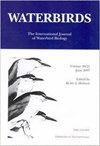基于美国密西西比州长期公民科学数据的铁路移民到达和离开时间趋势
IF 0.6
4区 生物学
Q3 ORNITHOLOGY
引用次数: 1
摘要
摘要人们对铁路移民生态知之甚少,因此限制了有效保护铁路人口的努力。因此,我们调查了密西西比州海洋泉北部的弗吉尼亚秧鸡(Rallus limicola)、国王秧鸡(Rallus elegans)和Sora秧鸡(Porzana carolina)的迁徙到达/离开日期的变化。利用过去25年收集的公民科学数据,我们检查了汇总数据,分别通过对每个物种在泻湖的首次或最后观测显示的主要到达和离开窗口模式,以及控制异常值的第10 /90分位数(即早到,晚离开)。回归模型没有发现任何物种在春季迁徙离场的差异。在秋季的移民中,我们发现只有弗吉尼亚铁路的移民有所不同,随着时间的推移,移民的时间变晚了。King Rail首先在9月中旬(9月22日)抵达秋季,随后是Sora(10月5日)和Virginia Rails(10月21日)。在春季迁徙中,Virginia Rails首先出发(3月19日),然后是King Rails(3月24日)和Sora(4月20日)。King Rails的趋势可能被一些具有非迁移行为的个体所扭曲。尽管存在局限性,但公民科学的努力对于铁路迁移生态学的初步调查是有用的,未来的应用可用于识别和评估影响迁移时间的因素(例如,气候变化、栖息地可用性、天气变化)。本文章由计算机程序翻译,如有差异,请以英文原文为准。
Trends in Rail Migration Arrival and Departure Times Using Long-Term Citizen Science Data from Mississippi, USA
Abstract. Little is known of rail migration ecology, consequently limiting efforts to effectively conserve rail populations. Therefore, we investigated changes in the migratory arrival/departure dates for Virginia Rails (Rallus limicola), King Rails (Rallus elegans) and Sora (Porzana carolina) north of Ocean Springs, Mississippi. Using citizen science data collected over the last 25 years, we inspected summarized data for patterns of primary arrival and departure windows indicated by first or last observations of each species at the lagoons, respectively, alongside 10th/90th quantiles that controlled for outliers (i.e., early arrivals, late departures). Regression models found no differences in spring migration departures for any species. In fall migration we found a difference only in Virginia Rail arrivals, which became later over time. King Rail arrived in autumn first in mid-September (September 22nd) followed by Sora (October 5th) and Virginia Rails (October 21st). In spring migration, Virginia Rails departed first (March 19th), then King Rails (March 24th), and Sora (April 20th). Trends for King Rails may have been skewed by some individuals having non-migratory behavior. Despite limitations, citizen science efforts were useful for an initial investigation of rail migration ecology, and future applications could be used to identify and assess factors affecting migration timing (e.g., climate change, habitat availability, weather shifts).
求助全文
通过发布文献求助,成功后即可免费获取论文全文。
去求助
来源期刊

Waterbirds
生物-鸟类学
CiteScore
1.30
自引率
0.00%
发文量
0
审稿时长
6-12 weeks
期刊介绍:
Waterbirds is an international scientific journal of the Waterbird Society. The journal is published four times a year (March, June, September and December) and specializes in the biology, abundance, ecology, management and conservation of all waterbird species living in marine, estuarine and freshwater habitats. Waterbirds welcomes submission of scientific articles and notes containing the results of original studies worldwide, unsolicited critical commentary and reviews of appropriate topics.
 求助内容:
求助内容: 应助结果提醒方式:
应助结果提醒方式:


